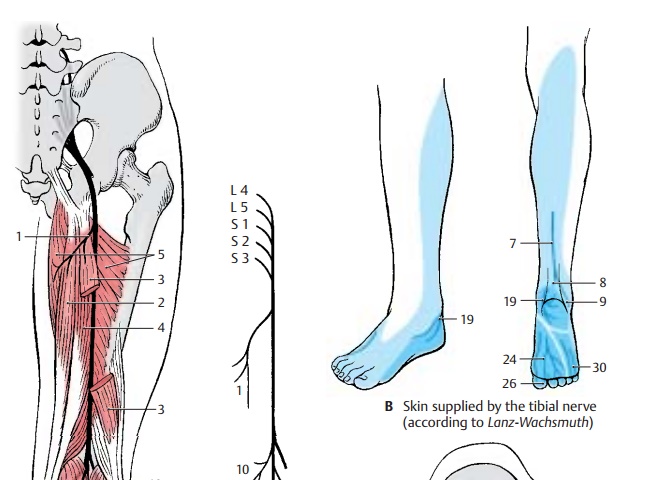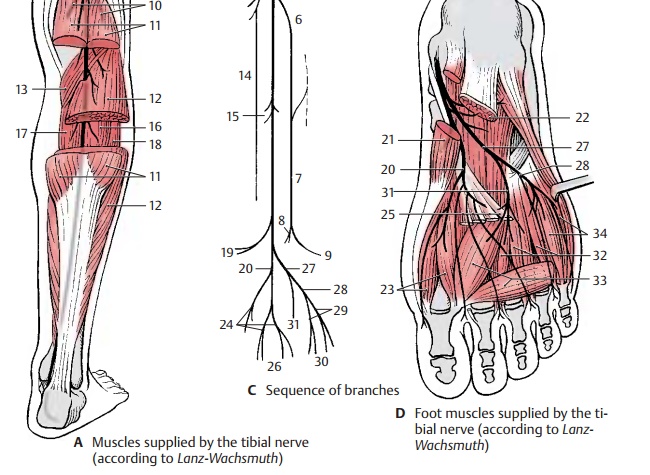Chapter: Human Nervous System and Sensory Organs : Spinal Cord and Spinal Nerves
Sciatic Nerve
Sciatic Nerve (L4 – S3)
The nerve has two components, the commonperoneal nerve (common fibular nerve) andthe tibial nerve; they appear as a uniform nerve trunk (AC1) because they are surrounded by a common connective-tissue sheath in the small pelvis and in the thigh. The sciatic nerve leaves the pelvis through the infrapiriform foramen and extends beneath the gluteus maximus muscle and biceps muscle along the posterior aspects of the internal obturator muscle, the quadrate muscle of femur, and the great adductor muscle in the direction of the knee joint. Peroneal nerve and tibial nerve separate above the knee joint. In the pelvis within the connective tissue sheath, the peroneal nerve is on the top and the tibial nerve below. In the thigh, the peroneal nerve lies laterally and the tibial nerve medially. However, both may run completely sepa-rately, in which case only the tibial nerve passes through the infrapiriform foramen, while the peroneal nerve penetrates the pir-iform muscle.
Common peroneal nerve (common fibu-lar nerve) (L4 – S2). In the thigh, the per-oneal part (AC2) of the sciatic nerve gives off a muscular branch to the short head of the biceps muscle of the thigh (A3).
After division of the sciatic nerve, the com-mon peroneal nerve extends along the bi-ceps muscle at the lateral edge of the pop-liteal fossa to the head of the fibula. It then winds around the neck of the fibula to the anterior aspect of the lower leg and enters into the long peroneal (fibular) muscle. The common peroneal nerve divides within this muscle into the superficial peroneal nerve (AC4) and the deep peroneal nerve (AC5). The superficial peroneal nerve is predomi-nantly sensory and runs between the long peroneal muscle and the fibula to the back of the foot. The deep peroneal nerve is pre-dominantly a motor nerve; it turns toward the front to the extensor muscles of the lower leg and extends on the lateral surface of the anterior tibial muscle to the back of the foot.
At the lateral margin of the popliteal fossa, the common peroneal nerve gives off two main branches for the skin, the lateral suralcutaneous nerve (A – C6), which supplies theskin at the lateral aspect of the lower leg, and the fibular communicating branch (C7), which joins the medial sural cutaneous nerve to form the sural nerve.
The superficial peroneal nerve gives off muscu-lar branches (AC8) to the long (A9) and short(A10) peroneal muscles. The rest of the nerve is exclusively sensory; it ramifies into terminal branches, the medial dorsal cu-taneous nerve (BC11) and the intermediate dorsal cutaneous nerve (BC12), which supplythe skin of the back of the foot except for the interdigital space between great toe and second toe.
The deep peroneal nerve gives off several muscular branches (AC13) to the extensor muscles of the lower leg and the foot, namely, to the anterior tibial muscle (A14), the long (A15) and short (A16) extensor muscles of toes, and the long (A17) and short (A18) extensor muscles of the great toe. The terminal branch is sensory and sup-plies the apposing skin surfaces of the inter-digital space between great toe and second toe (B19).
Clinical Note: Injury to the nerve affects theextensor muscles of the foot. The foot can no longer be lifted in the ankle joint. When walking, the foot hangs down and the toes drag along the floor. The leg must be lifted higher than normal, resulting in the so-called steppage gait.
Innervation of the skin (B).Autonomiczone (dark blue) and maximum zone (light blue).
Sciatic Nerve (continued) (A – D)


Tibial nerve (L4 – S3). Severalmotorbranches (AC1) originate from the tibial por-tion of the sciatic nerve, namely, those for the proximal and distal parts of the semi-tendinous muscle (A2), for the long head of the biceps muscle (A3), and a branch divid-ing further for the semimembraneous muscle (A4) and the medial part of the great adductor muscle (A5).
After the division of the sciatic nerve, the tibial nerve descends vertically through the middle of the popliteal fossa and under-neath the gastrocnemius muscle. It then lies under the tendinous arch of the soleus muscle and, further distal, between the long flexor muscle of the great toe and the long flexor muscle of toes. It extends between the tendons of both muscles to the back of the medial ankle and winds around it. Below the ankle, it divides into two terminal branches, the medial plantar nerve and the lateral plantar nerve.
The medial sural cutaneous nerve (C6) branches off in the popliteal fossa; it de-scends between the two heads of the gastrocnemius muscle and joins the com-municating branch of the peroneal nerve to form the sural nerve (BC7). The latter extends laterally from the Achilles tendon behind the lateral ankle and around it to the lateral aspect of the foot. It gives off the lateral cal-caneal branches (BC8) to the skin of thelateral side of the heel and the lateral dorsalcutaneous nerve (BC9) to the lateral aspect ofthe foot.
Also in the popliteal fossa, motor branches (AC10) go off to the flexor muscles of the lower leg, namely, to the two heads of the gastrocnemius muscle (A11), to the soleus muscle (A12), to the plantar muscle and the popliteal muscle (A13). The popliteal branch gives rise to the interosseous nerve of the leg (C14), which runs along the dorsal surface of the interosseous membrane and provides sensory innervation to the periosteum of the tibia, the upper ankle joint, and the tib-iofibular joint. The tibial nerve gives offmuscular branches (C15) to the posteriortibial muscle (A16), the long flexor muscle of toes (A17), and the long flexor muscle of the great toe (A18). Before the nerve trunk ramifies into terminal branches, it sends off the medial calcaneal branches (B19) to the me-dial skin area of the heel.
The medial of the two terminal branches, the medial plantar nerve (CD20), innervates the abductor muscle of the great toe (D21), the short flexor muscle of toes (D22), and the short flexor muscle of the great toe (D23). Finally, it divides into the three com-mon plantar digital nerves (BC24), whichsupply lumbrical muscles 1 and 2 (D25) and divide further into the proper plantar digital nerves (BC26 ) for the skin of the interdigital spaces from the great toe up to the fourth toe.
The second terminal branch, lateral plantarnerve (CD27), divides into a superficial branch (C28) with the common plantar digitalnerves (C29) and proper plantar digital nerves (BC30) for the skin of the little toearea and into a deep branch (CD31) with the muscular branches for the interosseousmuscles (D32), the adductor muscle of great toe (D33 ) and the three lateral lumbrical muscles. D34, short flexor muscle of the little toe.
Clinical Note: Injury of the tibial nerve leadsto paralysis of the flexor muscles of toes and foot. The foot can no longer be moved in plantar direc-tion: tiptoeing becomes impossible.
Innervation of the skin (B).Autonomiczone (dark blue) and maximum zone (light blue).


Related Topics